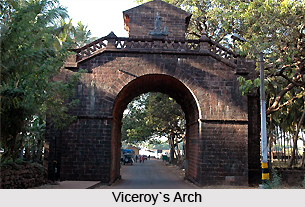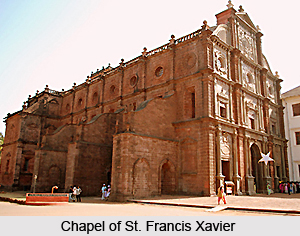The historical monuments of Goa or Old Goa as the region is referred to, consist of a number of ancient buildings. These have been converted into museums and the UNESCO has granted world heritage status to this once glorious town. Now a little more than a village, Old Goa was once a fabulous city where East met West. Even before the arrival of the Portuguese, it was a thriving city, the second capital of the Sultans of the Adil Shahi dynasty of Bijapur, a vast complex of mosques, temples and fortifications. Today only a small fragment of the old gateway to the Sultan`s palace survives; the rest dates from the Portuguese occupation. Here, set picturesquely among groves of coconut palms, are some outstanding Portuguese buildings. It is difficult to visualize the ancient maritime splendour of Old Goa as so many of the most important buildings have disappeared.
The city was protected by a continuous fortified wall. West of the present Chapel of St Catherine was Ribeira Grande or the Great Embankment, which housed the mint, gun foundry, arsenal and workshops, together with the Archbishop`s Prison, Aljube, Chapel of St Martin, College of St Bon-venture and the Royal Hospital. To the right of St Catherine`s Quay was Ribeira das Gales, where great galleys were built. Next was the Terreiro Grande, the commercial and administrative centre, including the Viceroy`s Palace and Custom House. To the East of the chapel lies the great market and to the south, the town of Goa, approached through the Viceroy`s Arch.
 A little distance away from the modern jetty lies the Viceroy`s Arch. It is a black stone monument built as a Centennial memorial to commemorate Vasco da Gama`s discovery of the Sea route to India. It was built under the orders of Vasco da Gama`s grandson, the Governor Francisco da Gama. It was designed as a triumphal arch and was decorated on the occasion of the entry of every new Viceroy. On the right-hand side is an inscription, 1656, the date of Portuguese emancipation from Spanish domain. In the niche at the top of the arch is a statue of Vasco da Gama; behind is a statue of the Argonaut. The arch was restored in 1954.
A little distance away from the modern jetty lies the Viceroy`s Arch. It is a black stone monument built as a Centennial memorial to commemorate Vasco da Gama`s discovery of the Sea route to India. It was built under the orders of Vasco da Gama`s grandson, the Governor Francisco da Gama. It was designed as a triumphal arch and was decorated on the occasion of the entry of every new Viceroy. On the right-hand side is an inscription, 1656, the date of Portuguese emancipation from Spanish domain. In the niche at the top of the arch is a statue of Vasco da Gama; behind is a statue of the Argonaut. The arch was restored in 1954.
To the left of the Viceroy`s Arch is the Gate of the Fortress of Adil Shah. Also constructed in black stone, it comprises a lintel carried on moulded pillars, flanked by the remains of perforated stone screens. Situated on a low plinth, it is purely Hindu in form and style and was probably built by Sabaji, the Hindu ruler of Goa before the Muslim conquest of 1471. The palace, demolished in 1920, was occupied by the Adil Shahi Sultans of Bijapur prior to the acquisition of Goa by the Portuguese in 1510.
The Palacio de Fortaleza or Palace of the fortress was the residence of the Portuguese viceroys from 1554 to 1695. It faced a large square surrounded by beautiful houses and was the most conspicuous building in the city. It is reputed that the walls of the palace were decorated with paintings of Portuguese ships that had sailed to India since the time of Vasco da Gama. In front of the palace stood the High Court, flanked by the Chief Jail or Tronco and, to the left, the royal magazines.
The Palace of the Inquisition was a fearful complex of prisons and dungeons. It was once a splendid edifice with a magnificent hall and vaulted front where over 16,172 cases were tried by the Inquisition. Nothing now remains of this magnificent structure.
Lying to the West of the Se Cathedral is the former Palace of the Archbishop. This links with the Convent of St Francis of Assisi, built by Franciscan friars in 1517 and restored in 1762 and 1765. The entrance portico is a fine example of Portuguese Gothic or Manueline architecture. The Convent is now an Archaeological Museum, which houses portraits of former Viceroys and many other artefacts.
 To the south of this church of St Cajetan, on the main road leading to Ponda, is the Gate of the College and Church of St Paul. The College was founded in 1541 to instruct converts in arts and sciences and to train them as preachers in their own languages. It possessed a vast library and in 1556 boasted the only printing-press in the East. Later it was abandoned in favour of a less pestilential location. Only the Doric facade of the church remains. In the grounds of the College is the Chapel of St Francis Xavier, founded in 1545. The present chapel, in a Doric style, was built in 1884.
To the south of this church of St Cajetan, on the main road leading to Ponda, is the Gate of the College and Church of St Paul. The College was founded in 1541 to instruct converts in arts and sciences and to train them as preachers in their own languages. It possessed a vast library and in 1556 boasted the only printing-press in the East. Later it was abandoned in favour of a less pestilential location. Only the Doric facade of the church remains. In the grounds of the College is the Chapel of St Francis Xavier, founded in 1545. The present chapel, in a Doric style, was built in 1884.
The Pilar Seminary lies in the village of old Goa is an ancient institution founded in 1613.It is situated on top of a hill over a temple of Lord Shiva. Relics of a headless Nandi and a rock carving of a Naga serpent were found at this site.
The Royal Hospital used to lie beside the Chapel of St. Catherine. It was established in 1510 by Albuquerque for the care and benefit of his soldiers, but later it was handed over to the Holy House of Mercy. The hospital was a fine two-storey building bearing the royal arms, which is now in the Museum.
To the west lay the Arsenal. This was demolished in 1869. Some of the cannon manufactured here can still be found in the fortresses of Goa, Daman and Diu.
Old Pillory lies in the centre of town. It is a single shaft of basalt which had iron rings affixed to it. It was once used to punish offenders.
Not much remains of the ancient historical monuments here, though this was the site of a great many architectural constructions. Due to its rich historical past, whatever remains has been protected by the international agency of the UNESCO.




